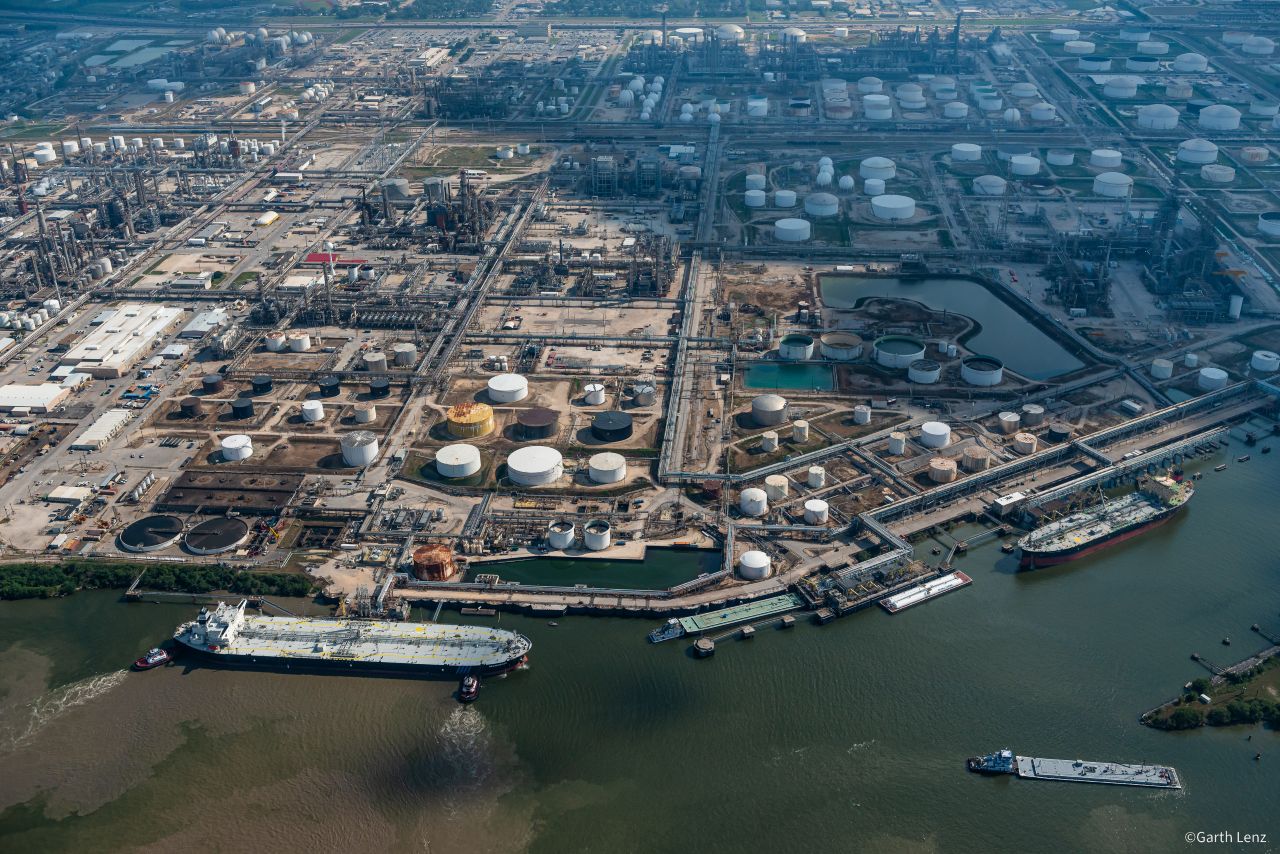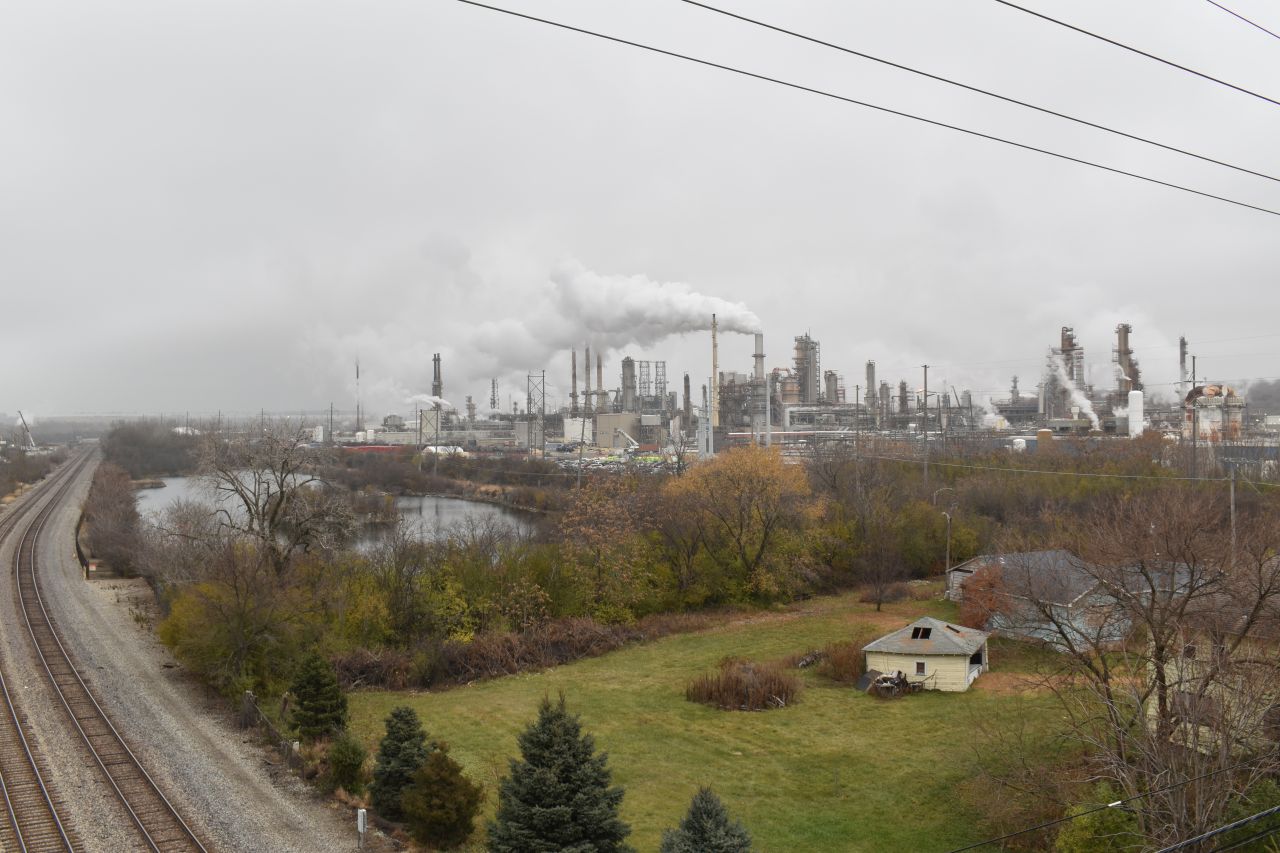At least 20 major oil and gas plants proposed in flood zones

All night and into the morning of Aug. 30, 2017, as flood waters caused by Hurricane Harvey approached the Chevron Phillips Chemical Complex in Sweeny, Texas, the plant’s workers scrambled to block the rising current. To hold back the muddy brown waters of the nearby Linnville Bayou, they piled up concrete and roll-off containers and erected inflatable dams.
According to a lawsuit filed by more than 400 residents and businesses in this small town an hour southwest of Houston, the efforts by Chevron and Phillips 66 to save their own plants led to flooding many neighboring properties.
“Because of the dams, the water levels rose significantly, flooding the inside of many homes and trapping many individuals inside of their houses for weeks,” the lawsuit states. “Livestock, fisheries, loved pets, orchards, sowed land, hay, and water wells were lost as well.
Flooding of hazardous sites is a constant risk in industrial zones along the Gulf Coast, where refinery communities sit in the crosshairs of both hurricanes and torrential rains. Despite the growing risk of flooding due to climate change and rising sea levels, a review of major new energy projects shows that energy companies continue to build their facilities in flood-prone areas.
Across the U.S., companies have proposed or are building at least 20 new oil and gas-related industrial facilities within the 100-year floodplain, defined as areas with a 1 percent chance of flooding each year, according to permits and other public records available on the Oil & Gas Watch database.
These major construction projects in the flood zone include seven liquefied natural gas (LNG) export terminals and cooling plants (five in Louisiana, two in Texas, and one in Florida); six natural gas compressor or regulation stations (all in Louisiana); two new crude oil terminals in Texas; and two new methanol plants in Louisiana.
These numbers are probably low, because the official federal delineation of the “flood zone” does not take into account projected rates of sea level rise due to a rapidly warming climate. Two thirds of these projects (14) are in Louisiana, which is losing miles of coastal wetlands every year (reducing buffers that could help protect waterfront development from flooding) and which suffered major losses during hurricanes Katrina, (2005), Rita (2005), Gustav (2008) and Ike (2008), among other storms.
Five of the proposed oil and gas projects are along the Texas Gulf coast. In the Houston area during Hurricane Harvey in 2017, intense rainfall and flooding triggered malfunctions at industrial plants that released more than eight million pounds of unpermitted air pollution and more than 150 million gallons of wastewater discharged by sewage plants and industry, according to an Environmental Integrity Project review of state records.
South of Houston, at the refinery and chemical plant in Sweeny, years before Hurricane Harvey hit, the companies’ staff did not properly assess whether a railyard expansion completed in 2016 would change drainage patterns in the area, the residents claimed in their lawsuit. The new construction had pushed the plant’s footprint even deeper into the Linnville Bayou’s 100-year floodplain.
In court filings, the companies maintained that the flooding was a strictly natural disaster.
“The high flows and inevitable flooding impacted tens of thousands, including hundreds of Phillips 66 and refinery employees,” company lawyers wrote in one 2019 response. “Phillips 66 sympathizes with its neighbors and all those affected but is in no way responsible for the property lost.”
The companies also argued in court that their “few emergency flood control actions” were necessary, and the plants experienced “minimal hydrocarbon releases” as the storm passed, according to records of the lawsuit. However, state records show that the Phillips 66's Sweeny refinery alone released more than 177,000 pounds of pollution in the week between Aug. 23 and Sept. 30, 2017.
Phillips 66 and Chevron Phillips Chemical later agreed to settlement deals with most of the residents.
Such conflicts are perhaps inevitable when oil refineries, plastics manufacturers, chemical plants, and other industrial facilities tend to cluster near rivers, bayous, and bays. Historically, these waterways were the main commodity transport routes, with railroads later following shipping lanes. That is one major reason why new sites tend to go in near historically industrial zones, which are often along waterways, according to Brown University environmental sociologist Scott Frickel.
“Once they're built, they don't go away,” Frickel said. “They get bought and sold and merged all the time. Ownership title is constantly changing, but the place itself doesn't change.”
However, shifting river and stream routes and changing land uses make it difficult to build resilient industrial facilities in flood-prone areas, according to Sam Brody, a Texas A&M University at Galveston professor who focuses on flood risk planning. That is particularly true if industrial sites are surrounded by homes, commercial districts, or other competing uses.
“It’s not just about changing climate or environmental conditions, it's changing human conditions that tee up the risk,” Brody said.
Jim Elliott, an environmental sociologist and professor at Rice University in Houston, has interviewed residents of neighborhoods next to refineries and chemical plant and worked with engineers to map the risk of leaking storage tanks in facilities along the Houston Ship Channel.
In a recent study with Frickel and New York University-Abu Dhabi post-doctoral student Thomas Marlow, Elliott and his colleagues looked at more than 6,000 “relic” industrial sites in six major U.S. cities along coasts and major rivers. They found the number of flood-prone homes on the same city block as a flood-prone contamination site ranged from around 1,000 in Minneapolis to 12,000 in Houston. Low-income residents and racial minorities were also more likely to live near to hazardous sites at risk of flooding.
Despite the clearly documented risk, federal and state regulations still allow industrial corporations to build brand-new facilities in flood zones, according to Elliott.
“Even when we know that there are these issues, it’s not exactly like we’re running in the right direction,” he said.















